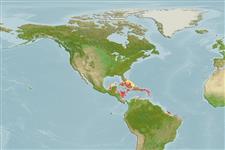>
Ophidiiformes (Cusk eels) >
Dinematichthyidae (Viviparous brotula)
Etymology: Ogilbichthys: Named for the great Australian ichthyologist, J. Douglas Ogilby; kakuki: Named for Brian Kakuk, Caribbean Marine Research Center, Lee Stocking Island, Bahamas.
Eponymy: James Douglas Ogilby (1853–1925) was an Irish-born Australian ichthyologist and taxonomist, son of the famous zoologist William Ogilby (below). [...] Brian Kakuk was a US Navy Diver (1981–1988) who then moved to the Bahamas, where he is co-owner, Bahamas Underground Cave Diving Facility and Diving Safety Officer, Caribbean Marine Research Center, Lee Stocking Island, Bahamas. [...] (Ref. 128868), visit book page.
More on authors: Møller, Schwarzhans & Nielsen.
Environment: milieu / climate zone / depth range / distribution range
Ecologia
marinhas associadas(os) a recifes; intervalo de profundidade 0 - 15 m (Ref. 55786). Tropical
Western Central Atlantic: Haiti and Bahamas.
Tamanho / Peso / Idade
Maturity: Lm ? range ? - ? cm
Max length : 6.7 cm SL macho/indeterminado; (Ref. 55786); 6.6 cm SL (female)
Descrição breve
Chaves de identificação | Morfologia | Morfometria
Raios dorsais moles (total) : 70 - 79; Raios anais moles: 53 - 61; Vértebras: 40 - 42. This species is characterized by the following: outer pseudoclasper wing-like with distinct knob at tip of inner face, isthmus between pseudoclaspers narrower than base of penis; broad anterior inner pseudoclasper; scale band on cheek with 1 or 2 rows on lower cheek; otolith with separate colliculi (Ref. 55786).
Found in coral reefs, but has also been caught 230 mm inside an ocean blue hole in the Exuma Cays, Bahamas. The eye is not particularly small, indicating that it is not a very specialized cave species. A 6.1 cm SL female specimen caught from San Salvador Island contained 50 immature embryos (4 mm length) and 40 eggs between 0.2-0.4 mm in diameter (Ref. 55786).
Life cycle and mating behavior
Maturidade | Reprodução | Desova | Ovos | Fecundidade | Larvas
Møller, P.R., W. Schwarzhans and J.G. Nielsen, 2004. Review of the American Dinematichthyini (Teleostei, Bythitidae). Part I. Dinematichthys, Gunterichthys, Typhliasina and two new genera. aqua, J. Ichthyol. Aquat. Biol. 8(4):141-192. (Ref. 55786)
Categoria na Lista Vermelha da IUCN (Ref. 130435: Version 2024-2)
Ameaça para o homem
Harmless
Utilização humana
Ferramentas
Relatórios especiais
Descarregue XML
Fontes da internet
Estimates based on models
Preferred temperature (Ref.
123201): 27 - 28.1, mean 27.6 °C (based on 333 cells).
Phylogenetic diversity index (Ref.
82804): PD
50 = 0.5078 [Uniqueness, from 0.5 = low to 2.0 = high].
Bayesian length-weight: a=0.00389 (0.00180 - 0.00842), b=3.12 (2.94 - 3.30), in cm total length, based on all LWR estimates for this body shape (Ref.
93245).
Nível Trófico (Ref.
69278): 3.3 ±0.5 se; based on size and trophs of closest relatives
Fishing Vulnerability (Ref.
59153): Low vulnerability (10 of 100).
